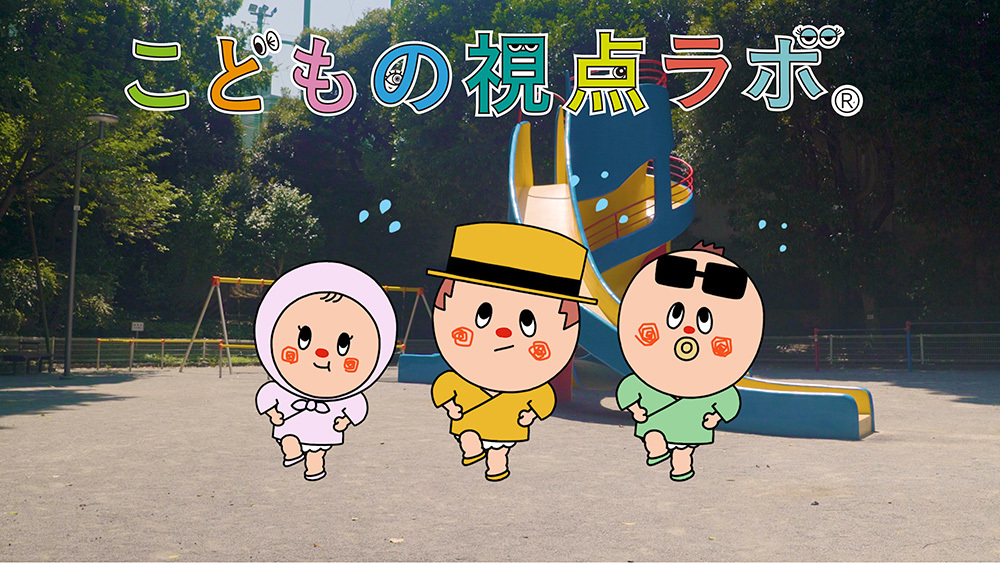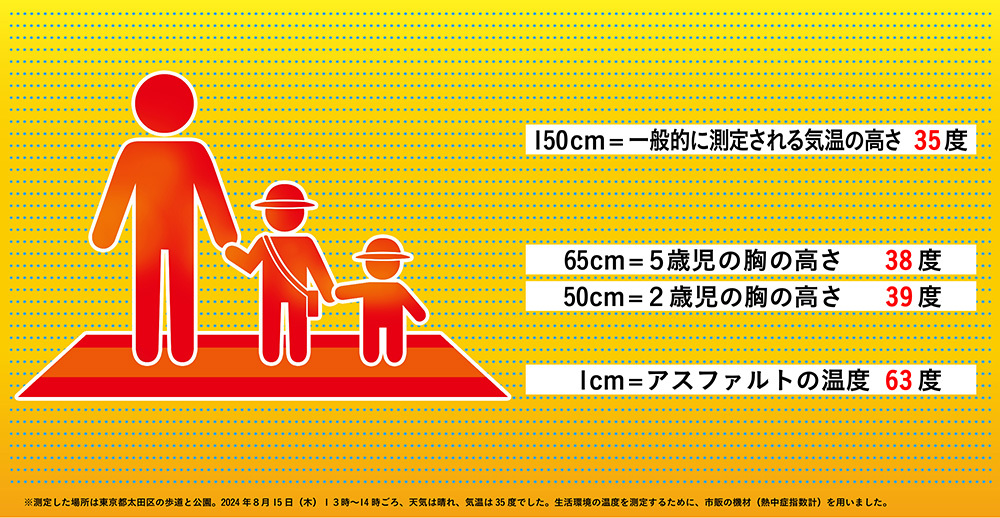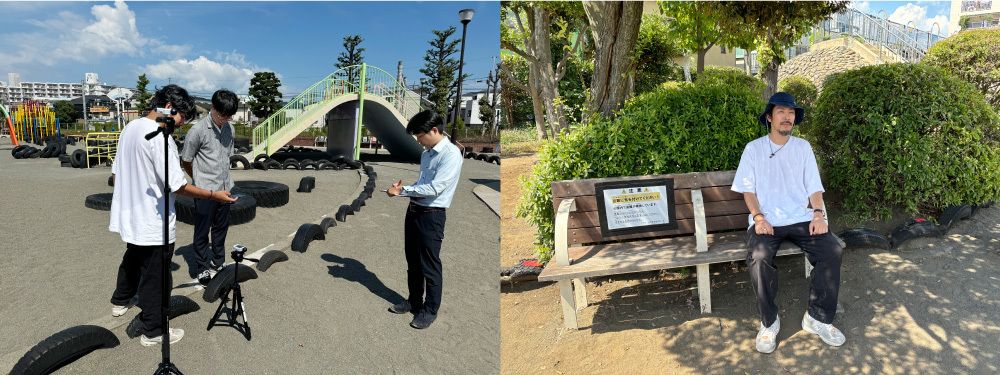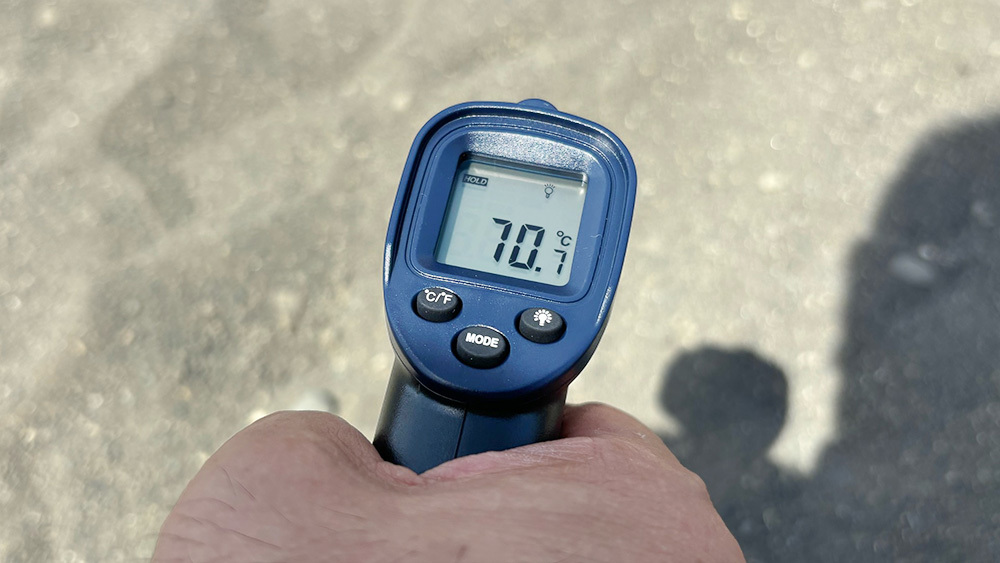It's been a while since our last Children's Perspective Lab Report. While we have several new "child research" projects underway, the extreme heat this summer prompted us to urgently advance our research on "infants' perceived temperature." This time, with the cooperation of Weather Map, Seihei Maeda and Mitsuhiro Kutsukake bring you the report.
Maeda: This summer's heat felt dangerous even for adults. Seeing my daughter (6 years old) trying to play energetically at the park despite it all made me worry repeatedly that she might get heatstroke. We've also started hearing more often that children, being closer to the ground than adults, experience higher perceived temperatures.
Kutsukake: With a 1-year-old at home, I was constantly worried when we went out. What kind of midsummer are infants and toddlers experiencing, unable to properly express "It's hot!" in words? We want to investigate this right away.
A forecast of 35°C felt like 39°C to a 2-year-old.
First, we measured how air temperature differs at different heights on a scorching day, with Weather Map present.
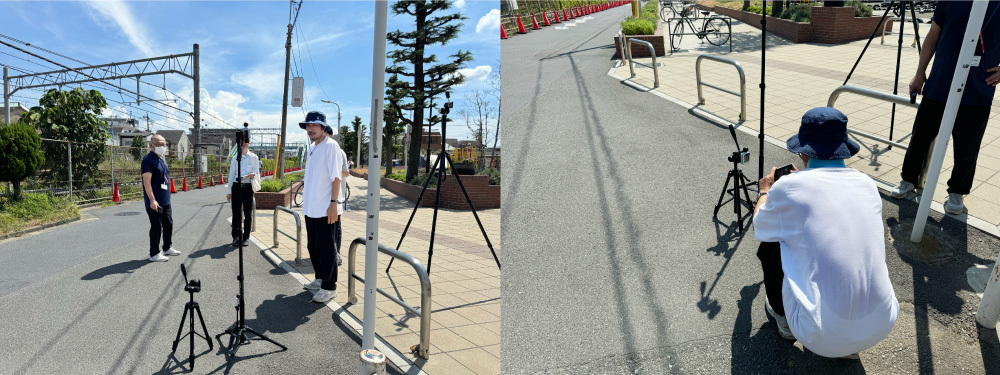
*Measurements taken on a sidewalk and in a park in Ota Ward, Tokyo. Date: Thursday, August 15, 2024, around 1:00 PM to 2:00 PM. Weather: Sunny. Air temperature: 35°C (95°F). Commercially available equipment (heat index meter) was used to measure the ambient temperature.
Incidentally, I learned for the first time while researching air temperature that the temperatures reported in the news are generally measured at a height of 150cm above the ground, in the shade. However, our living environments include sunny spots where we feel hotter than the air temperature suggests, and children's environments are closer to the ground. You'd expect areas near the heated ground to be hotter, but what's the reality?
Here are the actual results we measured (air temperature in direct sunlight).
Surprisingly! When the weather forecast says "Today's temperature is 35°C," a 5-year-old might be experiencing 38°C, and a 2-year-old 39°C.
Temperatures vary depending on the climate and ground conditions, so these figures are only from this specific measurement. However, it seems wise to assume this level of temperature difference for children's safety.
Playground equipment gets hotter than you'd imagine. Be careful not to get burned!
Next, let's assume a child is playing at the park and measure the equipment. As mentioned in the " Child's Time" article, while adults are watching, children play in various areas. Parks are empty now due to the heat, but there's a high chance a small child might run to the swings or slide as usual and touch them.
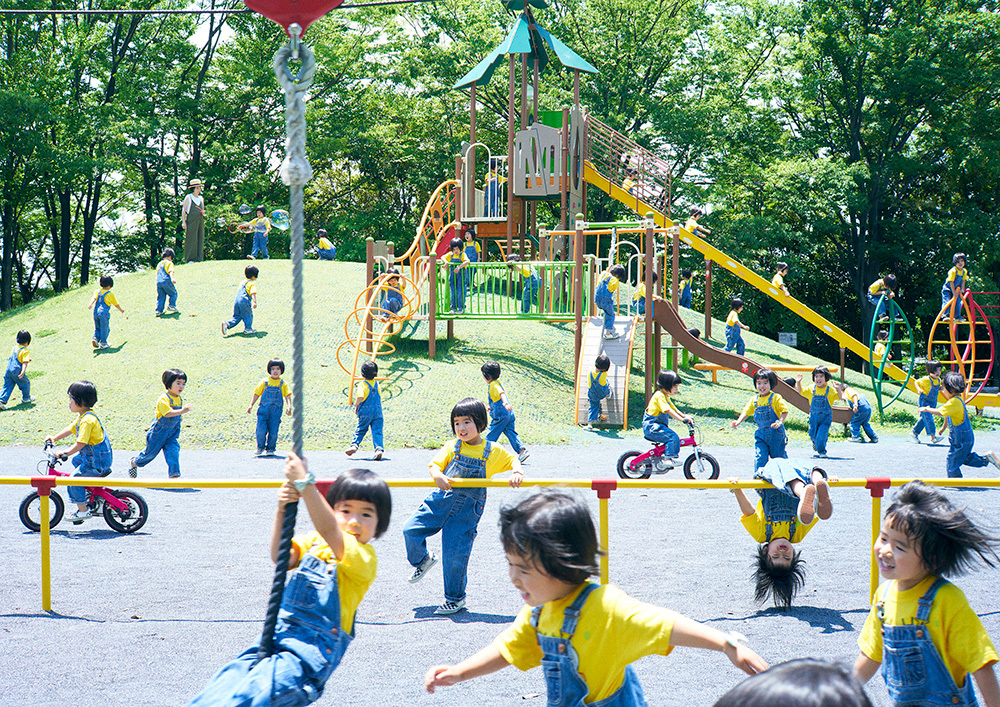
Children's Perspective Lab "Ito-chan's 30 Minutes" photo by Tenten
We actually measured the surface temperatures of various playground equipment.
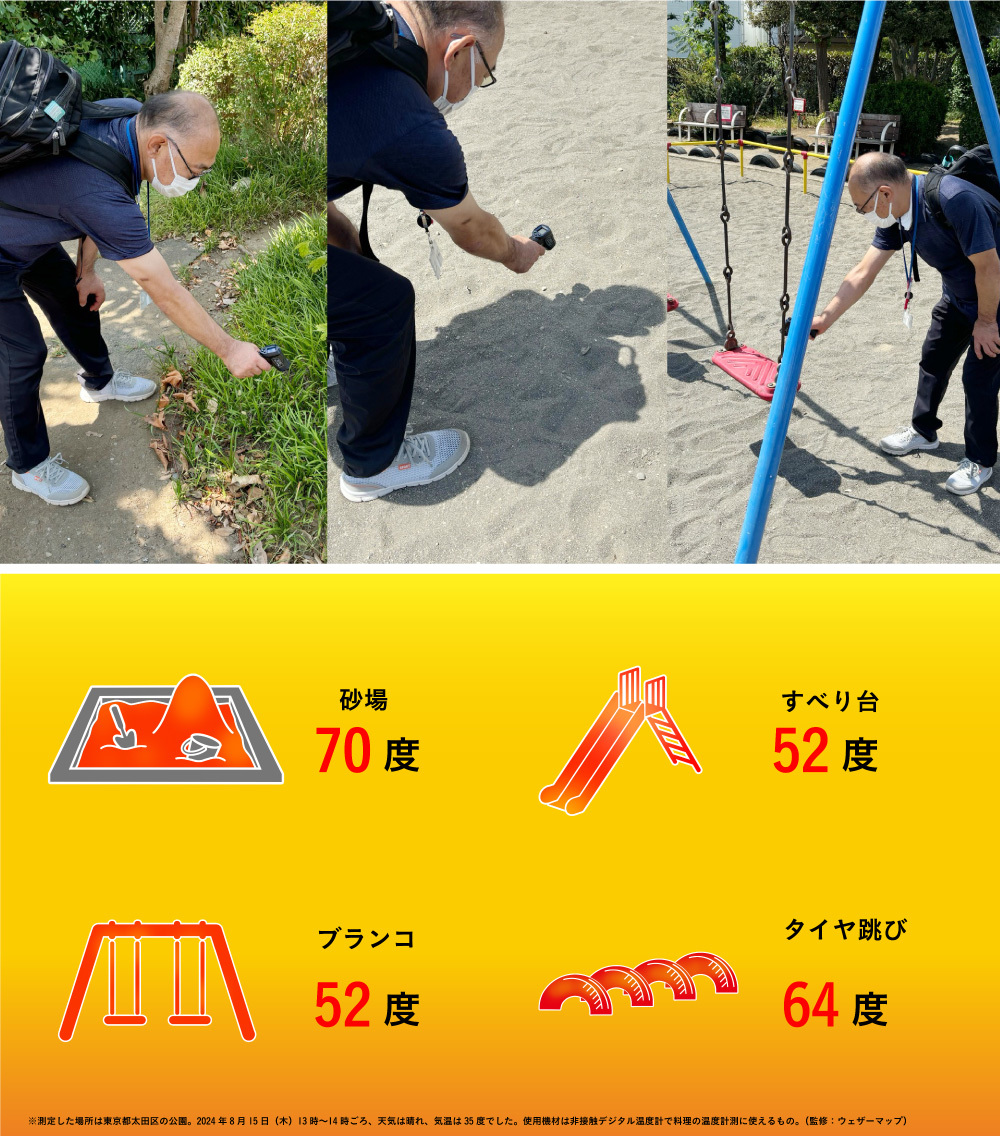
*Measurements taken on Thursday, August 15th at a park in Ota Ward, Tokyo. Weather: Sunny. Air temperature: 35°C (95°F). Equipment used: A non-contact digital thermometer suitable for cooking temperature measurements.
The hottest surface measured that day was... the sandbox at 70°C (158°F). The slide was 52°C (116°F). You could practically fry an egg on it. That's scary. News reports actually mention children getting burned on playground equipment during summer and needing hospital treatment. Kids often wear clothing that exposes skin in summer. Sliding down an aluminum slide in shorts could lead to serious trouble. By the way, the grass in the shade where adults were watching was 31°C (88°F). That gap is huge too.
Five minutes into our outing, I measured the stroller and baby carrier too.
Finally, I measured the temperature during transit. Of course, it's best to avoid going out when it's hot, but what about the temperature of strollers and baby carriers during short outings?
Here are the actual surface temperatures measured 5 minutes after going out.
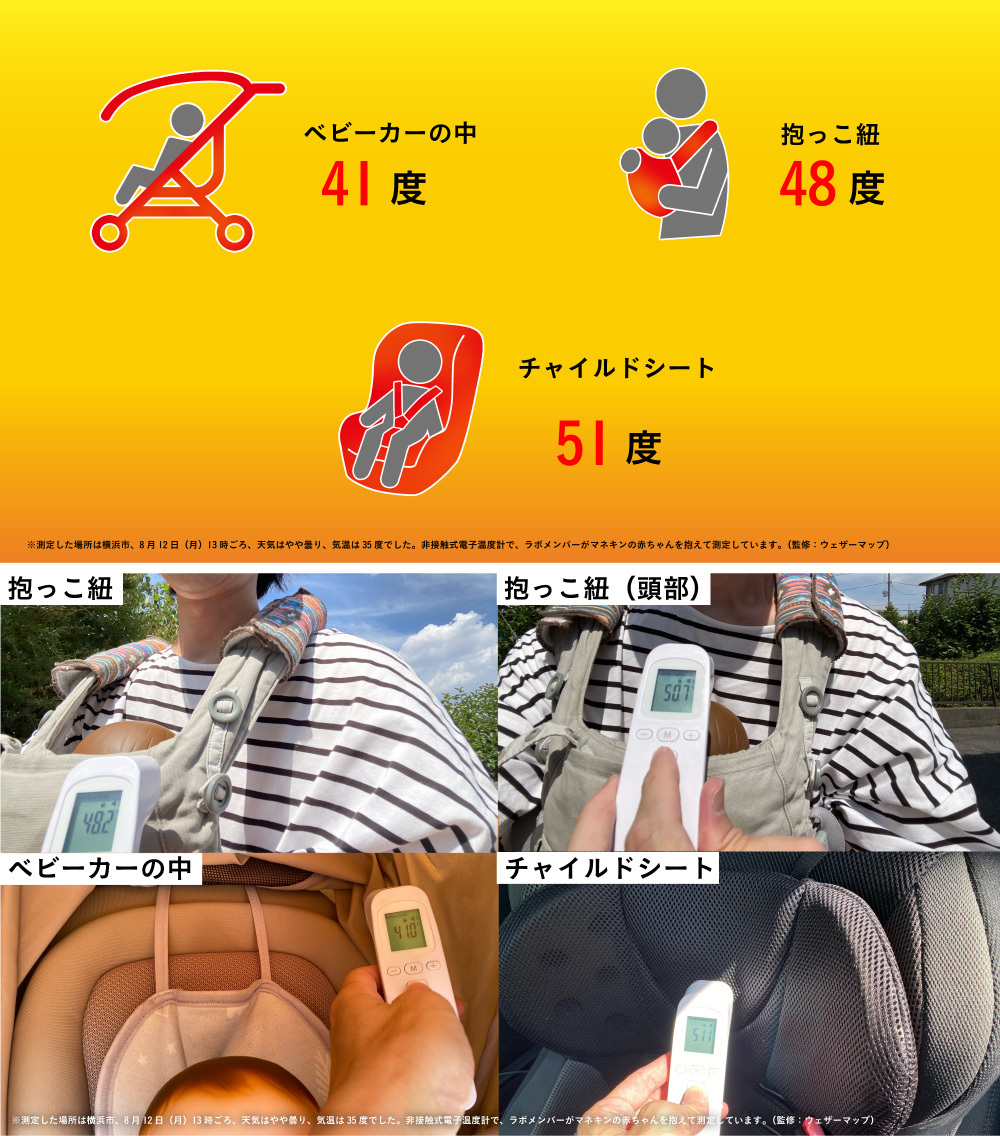
*Measurements taken in Yokohama City, around 1:00 PM on Monday, August 12th. Weather: Partly cloudy. Air temperature: 35°C (95°F). Measured using a non-contact electronic thermometer by a lab member holding a mannequin baby. (Supervised by: Weather Map)
Inside the stroller hood, even in the shade, it was a very high 41°C (106.8°F). The side of the baby carrier was 48°C (118.6°F). The black headrest, which absorbs light, was over 50°C (122°F)! The temperatures were incredibly high. I was surprised at how quickly the temperature rose, much faster than expected. This really highlights the importance of hats and ice packs.
Then, inside a parked car without the AC on, the child seat measured 51°C (114°F). Incidentally, the hood temperature at that moment was a shocking 74°C (157°F). This also highlights the danger of accidental burns to children.
To cool down a sealed, overheated car quickly: Open all windows, set the car's AC (auto mode) to outside air intake, and set the temperature to Lo (lowest). Drive for 10 minutes, then close the windows, switch the AC to recirculation mode, and drive for 3 more minutes.
We asked Dr. Miyake, an expert on heatstroke prevention, about infants and toddlers.
We've come to understand that the environment children experience during outings is significantly hotter/warmer than what adults feel. So, we asked Dr. Yasushi Miyake from Teikyo University School of Medicine, an expert in heatstroke prevention, what special precautions should be taken for infants and toddlers.
Maeda: Dr. Miyake, thank you for joining us. When I actually measured my child's environment, I was shocked by how hot it was. But my child just keeps playing at the park even in the heat. Are children actually okay with the heat?
Dr. Miyake (hereafter, Dr.): It's not that children can tolerate it better. In fact, because children have smaller bodies, they also have less water inside them. So they overheat quickly, cool down quickly, and dehydrate quickly.
Kutsukake: They overheat and dehydrate quickly?
Professor: For example, imagine two people in the same hot environment . A 60-kilogram adult and a 20-kilogram child, both with 60% body water. Naturally, the 20-kilogram child has less total water, so they'll feel the heat's impact and their body temperature will rise faster.
Maeda: Really! I thought kids were resilient to heat since they play without complaint, but it's actually the opposite. That's scary.
Doctor: The elderly and children are at higher risk for heatstroke. However, in practice, children are often under parental supervision, so cases rarely become severe enough to require hospitalization. Conversely, this means children need close monitoring. Paying attention to their facial expressions is helpful.
Kutsukake: So it's because their total body water volume is smaller. Are there any particular points to be careful about when it comes to hydration?
Doctor: Since their tank capacity is smaller, unlike adults, they can't drink large amounts of water at once. Therefore, frequent hydration is crucial. It might be helpful to think of it as "every 20 minutes when sweating." Of course, this varies greatly depending on the environment and the child's condition. It's important for adults to create opportunities for hydration before they get too thirsty. If you notice they're sweating heavily, dehydration has likely already begun.
Kutsukake: "Every 20 minutes when sweating." What other timing is good?
Teacher: For example, when they wake up in the morning, before heading out, or before and after bath time. It's good to be mindful of "before they dry out" and "after they dry out." And of course, they should drink properly during meals.
Maeda: Lately, when going out, we've been wrapping ice packs around their necks, or putting them inside baby carriers or stroller seats. Our lab members are each trying different things. But for heatstroke prevention, where should we cool them? I hear the neck, armpits, and groin are good.
Doctor: Well, those areas are fine when the child has a fever and is lying down. But when kids are moving around normally, you can't cool their armpits, right? The groin is also impossible if they're wearing a diaper. So, cool their head. The neck, armpits, and groin are areas where large veins run close to the skin's surface, allowing you to cool a large volume of blood flowing slowly. But actually, the head also has a lot of blood flowing through it. For example, wipe their head with a wet towel and fan them, or put a hooded hat on them that's been slightly dampened with cold water. For children, just cool the areas that are easiest to cool. You have to do it frequently for it to be effective, so keep that in mind too.
Kutsukake: For babies, what should we do when they're in a baby carrier, for example?
Doctor: Again, focus on areas that are easy to cool. For example, wrapping something around the neck risks entanglement, and cooling the stomach too much isn't good either. The head and back are still the best areas to target.
Maeda: My child sweats profusely. Is there anything I should be concerned about?
Doctor: Wiping them down with a damp towel or changing their clothes is best. Children's clothes are often cotton, but cotton sticks to the body when wet, reducing breathability. It also dries slowly, trapping heat. Change their clothes frequently, or consider using quick-drying fabrics, which are becoming more common.
Also, when they're sweating heavily, make sure they rest in a cool place. As mentioned earlier, because their bodies are small, they're more affected by their environment and can overheat quickly. Basically, always keep these three things in mind: "cooling," "rest," and "hydration."
Kutsukake: Babies sweat easily, but they don't usually drip beads of sweat.
Doctor: That's right. Since it's hard to judge by how much they sweat, signs of heatstroke include fussiness or a sudden lack of energy after being active. It's crucial to watch for any unusual changes.
Maeda: I see. That makes perfect sense. Thank you very much.
To help people understand children's temperature perception, we created the Bon dance "Kodomo Ondo."
Based on these measurements and Dr. Miyake's insights, we created new content conveying heat/temperature from a child's perspective. That's "Kodomo Ondo." It's a bon dance designed to help people remember the gap between how adults and children perceive heat/temperature and how to respond. Yes, it's a pun on "temperature" (温度) and "ondo" (音頭, a type of folk song) (laughs). The song is performed by Lemon Nakanishi, a rising star singer who's heating up the Kanto bon dance scene with her Eshu Ondo style!

The first verse explains the difference in temperature around the body due to height.
The second verse is about the surface temperatures of things you touch in the park.
3. About moving babies
These are tips for preventing heatstroke, meant to be remembered in those fleeting moments.
This time, we created choreography for the Bon dance along with the song. We hope that by listening to "Kodomo Ondo," children will naturally become aware of temperature from their perspective. By the way, my daughter listened to the demo version so much during development that she can already sing it. Someday, I hope we can all dance together at a summer festival! Well, the lingering summer heat continues, so please take good care to prevent heatstroke, both adults and children.
Results may vary depending on the material of items like playground equipment or baby carriers, as well as differences in the measurement environment. Please understand these are simply the results from this particular measurement.
Now, here's a summary of this report.
● On a forecast 35°C scorcher, the temperature at a 2-year-old's height was a whopping 39°C!? Remember: the closer to the ground, the hotter it feels. Don't push them too hard.
● Outdoor play equipment on a midsummer day, like a slide, can reach 52°C (120°F)! Be careful of accidental burns from touching it.
● Even just 5 minutes after heading out, the temperature inside a stroller, baby carrier, or car seat can skyrocket. The head, being dark and heat-absorbing, gets especially hot, so a hat is essential.
●Children have smaller bodies and less body water. They overheat quickly and dehydrate faster than adults, so hydrate them more frequently.
●The three basics of heatstroke prevention are "cool down," "rest," and "hydrate." Infants and toddlers especially can't tell you they feel unwell, so watch for unusual signs like fussiness or lethargy.






